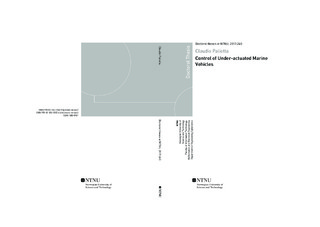| dc.contributor.advisor | Pettersen, Kristin Y. | |
| dc.contributor.author | Paliotta, Claudio | |
| dc.date.accessioned | 2017-09-22T12:45:10Z | |
| dc.date.available | 2017-09-22T12:45:10Z | |
| dc.date.issued | 2017 | |
| dc.identifier.isbn | 978-82-326-2553-6 | |
| dc.identifier.issn | 1503-8181 | |
| dc.identifier.uri | http://hdl.handle.net/11250/2456310 | |
| dc.description.abstract | In this dissertation, various topics related to control problems for under-actuated marine vehicles are investigated. The thesis is divided into three parts.
The first part deals with the source-seeking problem for multi-agent systems. It is assumed that a group of vehicles has to identify the location of a source in the ocean space. The source may for instance be an area with a high concentration of a specific chemical substance. The agents have to define the direction of motion towards the source utilizing distributed measurements of the scalar field surrounding the source. It is supposed that the agents are organized in a leaderfollower scheme. An approach for kinematic unicycle agents is first presented. In this approach the novelty is a variable-leader scheme. That is, it is assumed that the leader can change during the mission. This allows for a better distribution of the tasks in the group. In particular, there is an agent in the group which has information about the direction where to move in order to explore an area of interest. Then there is also another agent that can take on the role as leader if it gets satisfactory measurements from the environment. This approach is then used in order to develop a strategy for multi-agent systems consisting of under-actuated marine vehicles. In this second case, a synchronization controller is used for the vehicles in order to achieve motion in formation. The leader agent collects information from the followers and is able to compute the direction pointing towards the source, computing the approximated gradient of the field surrounding the source. Simulation case studies are presented in order to validate the approaches.
In the second part of the thesis a novel approach for controlling under-actuated marine vehicles is presented. The approach is inspired by works on control of nonholonomic ground vehicles. The method is based on the definition of a different output for the system. Then an input-output feedback linearization controller is used in order to apply a change of inputs to the system. This methods transforms the nonlinear model an under-actuated marine vehicle into a system with a linear external dynamics and a nonlinear internal dynamics. We use this approach to solve the trajectory tracking control problem, the path following control problem and the leader-follower synchronization control problem for marine vehicles in presence of environmental disturbances. Simulation case studies and experimental results validate the theoretical results.
The third part of the thesis deals with the path following control problem for under-actuated marine vehicles. First the path following control problem is dealt with for unparametrized straight-line paths. A guidance law inspired by a common control approach for aerial vehicles is developed. The guidance is based on geometric control principles and it is used together with an observer in order to counteract the effect of ocean currents. Almost-global stability of the closedloop system is proven and a simulation case study validates the theoretical result. Then the path following problem for curved paths is considered. In particular, paths parametrized by a path variable are considered. Two strategies are considered. Both the strategy are based on a parametrization of the curve which is used to propagate a path-tangential frame. The path following errors are defined with respect to the path-tangential frame. The first strategy forces the vehicle to move along the normal of the path-tangential frame. This results in a singularity which makes the strategy valid only locally around the path. The second strategy defines a different path parametrization which is valid globally. Here an ocean current observer is also used in order to counteract the ocean current disturbance. The closed-loop system is proven to be globally asymptotically stable. The theoretical results are verified via numerical simulations. Finally, a novel control strategy for path following of curved paths is presented. The novelty of this last approach is that it does not require any parametrization of the path. In fact, the path is implicitly defined as a manifold in the state space. The control approach is based on geometric control and hierarchical control design. An adaptive controller is used in order to deal with the disturbance caused by ocean currents. The closed-loop system is proven to be asymptotically stable. | nb_NO |
| dc.language.iso | eng | nb_NO |
| dc.publisher | NTNU | nb_NO |
| dc.relation.ispartofseries | Doctoral theses at NTNU;2017:240 | |
| dc.title | Control of Under-actuated Marine Vehicles | nb_NO |
| dc.type | Doctoral thesis | nb_NO |
| dc.subject.nsi | VDP::Technology: 500::Information and communication technology: 550::Technical cybernetics: 553 | nb_NO |
| dc.description.localcode | Digital fulltext not available | nb_NO |
